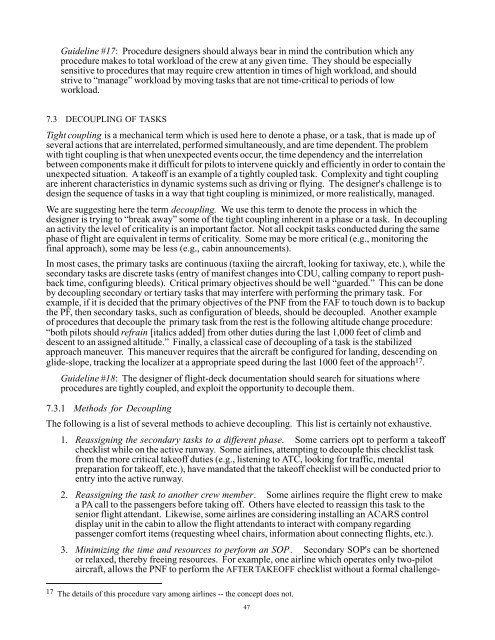On the Design of Flight-Deck Procedures - Intelligent Systems ...
On the Design of Flight-Deck Procedures - Intelligent Systems ...
On the Design of Flight-Deck Procedures - Intelligent Systems ...
Create successful ePaper yourself
Turn your PDF publications into a flip-book with our unique Google optimized e-Paper software.
Guideline #17: Procedure designers should always bear in mind <strong>the</strong> contribution which anyprocedure makes to total workload <strong>of</strong> <strong>the</strong> crew at any given time. They should be especiallysensitive to procedures that may require crew attention in times <strong>of</strong> high workload, and shouldstrive to “manage” workload by moving tasks that are not time-critical to periods <strong>of</strong> lowworkload.7.3 DECOUPLING OF TASKSTight coupling is a mechanical term which is used here to denote a phase, or a task, that is made up <strong>of</strong>several actions that are interrelated, performed simultaneously, and are time dependent. The problemwith tight coupling is that when unexpected events occur, <strong>the</strong> time dependency and <strong>the</strong> interrelationbetween components make it difficult for pilots to intervene quickly and efficiently in order to contain <strong>the</strong>unexpected situation. A take<strong>of</strong>f is an example <strong>of</strong> a tightly coupled task. Complexity and tight couplingare inherent characteristics in dynamic systems such as driving or flying. The designer's challenge is todesign <strong>the</strong> sequence <strong>of</strong> tasks in a way that tight coupling is minimized, or more realistically, managed.We are suggesting here <strong>the</strong> term decoupling. We use this term to denote <strong>the</strong> process in which <strong>the</strong>designer is trying to “break away” some <strong>of</strong> <strong>the</strong> tight coupling inherent in a phase or a task. In decouplingan activity <strong>the</strong> level <strong>of</strong> criticality is an important factor. Not all cockpit tasks conducted during <strong>the</strong> samephase <strong>of</strong> flight are equivalent in terms <strong>of</strong> criticality. Some may be more critical (e.g., monitoring <strong>the</strong>final approach), some may be less (e.g., cabin announcements).In most cases, <strong>the</strong> primary tasks are continuous (taxiing <strong>the</strong> aircraft, looking for taxiway, etc.), while <strong>the</strong>secondary tasks are discrete tasks (entry <strong>of</strong> manifest changes into CDU, calling company to report pushbacktime, configuring bleeds). Critical primary objectives should be well “guarded.” This can be doneby decoupling secondary or tertiary tasks that may interfere with performing <strong>the</strong> primary task. Forexample, if it is decided that <strong>the</strong> primary objectives <strong>of</strong> <strong>the</strong> PNF from <strong>the</strong> FAF to touch down is to backup<strong>the</strong> PF, <strong>the</strong>n secondary tasks, such as configuration <strong>of</strong> bleeds, should be decoupled. Ano<strong>the</strong>r example<strong>of</strong> procedures that decouple <strong>the</strong> primary task from <strong>the</strong> rest is <strong>the</strong> following altitude change procedure:“both pilots should refrain [italics added] from o<strong>the</strong>r duties during <strong>the</strong> last 1,000 feet <strong>of</strong> climb anddescent to an assigned altitude.” Finally, a classical case <strong>of</strong> decoupling <strong>of</strong> a task is <strong>the</strong> stabilizedapproach maneuver. This maneuver requires that <strong>the</strong> aircraft be configured for landing, descending onglide-slope, tracking <strong>the</strong> localizer at a appropriate speed during <strong>the</strong> last 1000 feet <strong>of</strong> <strong>the</strong> approach 17 .Guideline #18: The designer <strong>of</strong> flight-deck documentation should search for situations whereprocedures are tightly coupled, and exploit <strong>the</strong> opportunity to decouple <strong>the</strong>m.7.3.1 Methods for DecouplingThe following is a list <strong>of</strong> several methods to achieve decoupling. This list is certainly not exhaustive.1. Reassigning <strong>the</strong> secondary tasks to a different phase. Some carriers opt to perform a take<strong>of</strong>fchecklist while on <strong>the</strong> active runway. Some airlines, attempting to decouple this checklist taskfrom <strong>the</strong> more critical take<strong>of</strong>f duties (e.g., listening to ATC, looking for traffic, mentalpreparation for take<strong>of</strong>f, etc.), have mandated that <strong>the</strong> take<strong>of</strong>f checklist will be conducted prior toentry into <strong>the</strong> active runway.2. Reassigning <strong>the</strong> task to ano<strong>the</strong>r crew member. Some airlines require <strong>the</strong> flight crew to makea PA call to <strong>the</strong> passengers before taking <strong>of</strong>f. O<strong>the</strong>rs have elected to reassign this task to <strong>the</strong>senior flight attendant. Likewise, some airlines are considering installing an ACARS controldisplay unit in <strong>the</strong> cabin to allow <strong>the</strong> flight attendants to interact with company regardingpassenger comfort items (requesting wheel chairs, information about connecting flights, etc.).3. Minimizing <strong>the</strong> time and resources to perform an SOP. Secondary SOP's can be shortenedor relaxed, <strong>the</strong>reby freeing resources. For example, one airline which operates only two-pilotaircraft, allows <strong>the</strong> PNF to perform <strong>the</strong> AFTER TAKEOFF checklist without a formal challenge-17 The details <strong>of</strong> this procedure vary among airlines -- <strong>the</strong> concept does not.47
















